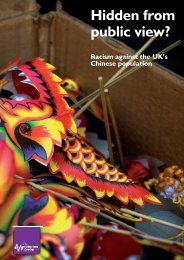Coming of Age : 1976 and the Road to Anti-Racism
Coming of Age : 1976 and the Road to Anti-Racism by Jagdish Patel and Suresh Grover
Coming of Age : 1976 and the Road to Anti-Racism
by Jagdish Patel and Suresh Grover
Create successful ePaper yourself
Turn your PDF publications into a flip-book with our unique Google optimized e-Paper software.
... it is also<br />
abundantly clear that<br />
because Black, in <strong>the</strong><br />
UK, had taken on a<br />
political meaning<br />
derived from its<br />
anti-colonial<br />
provenance, it<br />
attracted <strong>to</strong> its<br />
st<strong>and</strong>ard immigrants<br />
from <strong>the</strong> Indian<br />
sub-continent,<br />
Africans <strong>and</strong><br />
Indo-Caribbeans. In<br />
fact, Ajoy Ghosh from<br />
India <strong>and</strong> Roy Sawh<br />
from Guyana played<br />
a large part in <strong>the</strong><br />
UCPA, Farrukh<br />
Dhondy <strong>and</strong> Mala Sen<br />
in <strong>the</strong> Pan<strong>the</strong>rs, Tony<br />
Soares (from Goa) in<br />
<strong>the</strong> Black Liberation<br />
Front, <strong>and</strong> Sri Lankan<br />
A. Sivan<strong>and</strong>an as a<br />
fellow-traveller <strong>of</strong> <strong>the</strong><br />
BuFP ....<br />
Chinese, Cypriots, Sikhs, children, youth, families, workers –<br />
literally hundreds <strong>of</strong> studies, which would now be called ethnographic,<br />
came from <strong>the</strong> IRR stable. And even when studies<br />
looked at political organisation within ethnic communities, <strong>the</strong>y<br />
tended <strong>to</strong> be ethnographic ra<strong>the</strong>r than political <strong>and</strong> tediously<br />
detailed ra<strong>the</strong>r than enlightening – for example, Indian Workers’<br />
Associations in Britain by Dewitt John (1969) <strong>and</strong> The Politics <strong>of</strong><br />
<strong>the</strong> Powerless: a study <strong>of</strong> <strong>the</strong> Campaign Against Racial Discrimination<br />
by Benjamin Heineman Jnr (1972). But <strong>the</strong> latter <strong>and</strong><br />
<strong>the</strong> comprehensive <strong>to</strong>me by Sheila Patterson Immigration <strong>and</strong><br />
Race Relations in Britain 1960–1967 (1969), as well as <strong>the</strong> now<br />
no<strong>to</strong>rious Colour <strong>and</strong> Citizenship by E. J. B. Rose, et al. (1969)(8)<br />
which summed up a whole plethora <strong>of</strong> research projects in <strong>the</strong><br />
1960s, are well worth using as reference <strong>to</strong>ols.<br />
However, <strong>the</strong> ‘<strong>the</strong>m as a social problem’ <strong>to</strong>ne was punctured<br />
by three key books by <strong>the</strong> subalterns: Journey <strong>to</strong> an<br />
Illusion: <strong>the</strong> West Indian in Britain (1966) was written by London<br />
Transport worker Donald Hinds, who was also a cub reporter<br />
for The West Indian Gazette <strong>and</strong> Black British: White British<br />
by Indian journalist Dilip Hiro (1973) both published by a mainstream<br />
publisher <strong>and</strong> <strong>the</strong> latter released as a Penguin paperback<br />
in 1992. Edward Scobie, a Dominican journalist who had<br />
edited <strong>the</strong> magazine Flamingo in <strong>the</strong> early 1960s, wrote <strong>the</strong><br />
telling Black Britannia: a his<strong>to</strong>ry <strong>of</strong> Blacks in Britain (1972) half<br />
on <strong>the</strong> post-war situation but, published in <strong>the</strong> US, it was hard<br />
<strong>to</strong> find copies in <strong>the</strong> UK. All <strong>of</strong> <strong>the</strong>se, <strong>the</strong> latter two with useful<br />
indexes, give an excellent flavour <strong>of</strong> life in Britain from what<br />
some termed ‘<strong>the</strong> worm’s eye view’.<br />
But <strong>the</strong> worm had already turned! There may not have<br />
been in <strong>the</strong> 1950s <strong>and</strong> ’60s <strong>the</strong> time, <strong>the</strong> money, <strong>the</strong> contacts,<br />
for <strong>the</strong> writing <strong>of</strong> many Black books, but <strong>the</strong>re was an extremely<br />
vibrant <strong>and</strong> variegated Black press – which ran <strong>the</strong> gamut<br />
from <strong>the</strong> coloured glossy Flamingo magazine with eye-catching<br />
women on <strong>the</strong> cover <strong>to</strong> small cyclostyled <strong>and</strong> folded occasional<br />
broadsheets like The Black Ram or Black Chat, cl<strong>and</strong>estinely<br />
produced in someone’s front room – telling it like it was. At<br />
least forty black magazines/papers/journals were produced between<br />
1958 <strong>and</strong> 1970.9 one <strong>of</strong> <strong>the</strong> first <strong>and</strong> longest running was<br />
<strong>Coming</strong> <strong>of</strong> <strong>Age</strong> | 181<br />
<strong>Coming</strong> <strong>of</strong> <strong>Age</strong> Final version 16.10.indd 181 17/10/2017 12:08







